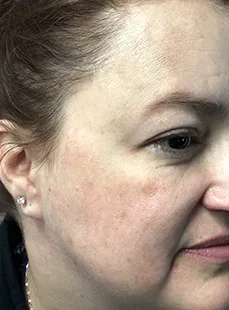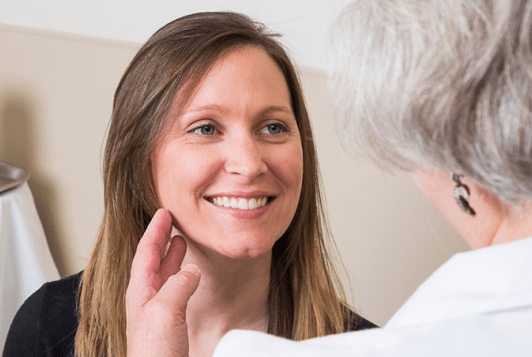April 18, 2019

I get a lot of questions in the Denver Health Dermatology clinic about brown spots appearing on skin and more importantly how to get rid of them. This is an especially important topic as the weather gets warmer.
First let’s start with explaining why you have them and how can you prevent them and then we will get into how to treat them.
Why Am I Getting Dark Spots On My Face?
Brown spots are caused by the overproduction of melanin in your skin. Melanin is the pigment that gives your skin, hair and eyes their color. It is produced by cells called melanocytes. Think of melanocytes as sponges that soak up sunlight. The more ultraviolet (UV) exposure your skin gets, the more saturated with melanin your sponges will get. Contrary to popular belief dark-skinned individuals do not have more melanocytes. Light and dark-skinned people have similar numbers of melanocytes on our skin. The difference is in the pigment-containing organelles, called melanosomes, which are larger, more numerous and more pigmented in dark compared to light-skin people.
To make this quite simple, there are four main reasons that you would see brown spots on your skin:
- Sun exposure
- Hormonal changes
- Genetics
- Age
Brown spots, known medically as solar lentigo (lentigines plural), are a common part of the aging process of your skin. Many people call them “age spots” or “liver spots” but dermatologists prefer to call them “wisdom spots” because we collect more of them the older/wiser we get. Roughly 75 percent of Caucasian people over the age of 60 are likely to have one or more of these lesions. These spots develop in response to sun damage. Somewhere in your life, you must have not used sunscreen regularly, may have enjoyed tanning out in the sun a bit too much or you used tanning beds.
For us women, some other reasons for brown spots or darkening of the skin on the face are hormonal changes, especially during pregnancy. Yes, we women have yet another reason to stress when pregnant. Don’t worry, the pregnancy glow is still real but while your acne may clear during pregnancy and your hair may start growing like weeds, the skin on your face may start to experience a hormone-related darkening called melasma. It is known as “the mask of pregnancy” and it appears as brown patches on the upper lip, forehead and cheeks. Suddenly, you have a brown mustache! It is very common in moms-to-be but also in women who take birth control pills. It can simply be due to changes in the estrogen and progesterone levels that happen during the regular menstrual cycle too.
Is There Anything I Can Do to Prevent Getting More Brown Spots?
Of course! Sun exposure is the biggest factor that can contribute to darkening of the skin. Good UV protection includes:
- Wearing Sunscreen daily with an SPF 30 or higher
- Wearing sun protective clothing with Ultraviolet Protection Factor (UPF)
- Wearing a wide-brimmed hat or use an umbrella to block the sun
- Re-applying sunscreen every two hours when out in the sun
I’ve heard patients say, “I do not like how sunscreen makes me look,” or “I am allergic to all sunscreens,” or “I do not like how it makes my skin feel” – yes, we have heard it all. Let me give you the news, the right sunscreen for you does already exist but you will need to find it through trial and error. I always tell my patients the best sunscreen is the one you will use!
The Environmental Protection Agency (EPA) provides a forecast of the expected risk of overexposure to UV radiation from the sun in your zip code. You can track it on your smartphone through the SunWise UV Index App to plan your outdoor adventures responsibly.
Another app I recommend downloading is called Sunface. If you are not convinced yet that sun protection is worth the effort, take a selfie with the Sunface App and find out what your face will look like in five, 10, 15, 20 and 25 years if you use tanning beds or if you do not use sun protection. It is rather scary.
Additionally, make sure to moisturize your skin well and use a gentle facial cleanser such as Cerave or Vanicream wash because trauma to the skin, dryness or irritation can also worsen the darkening of your skin.
How Can I Treat the Brown Spots That I Already Have on My Face?
Brown spots are not dangerous. The only reason to have them treated is cosmetic – because we feel it will improve our appearance, make us look younger and ultimately enhance our self-esteem. Treating existing hyperpigmentation is harder than preventing it and is much more expensive.
- Lightening creams: These are easily accessible but are they safe? There are over-the-counter skin-lightening creams such as kojic acid serums, vitamin C serums, lactic, azelaic and glycolic acid preparations, which are relatively safe. There are also over-the-counter and prescription strength hydroquinone creams, which are rather controversial because they increase the risk for developing a skin condition called ochronosis. This is a blue-gray pigmentation caused by the long term use of hydroquinone. It may or may not go away after stopping the use of hydroquinone. My advice is to be super cautious with this one if you do not want more problems.
- Retinoids or Vitamin A derivatives: These are also helpful in the fight for younger and lighter skin. They stimulate the production of collagen and exfoliate the skin gently by speeding up the cell turn over. They may cause irritation to the skin so start using your retinoid slowly – 2-3 times a week at first, then increase frequency of use gradually, moisturize and use excellent sun protection. An over-the-counter Vitamin A derivative called Differin (adapalene) gel used to require a prescription. I recommend that you start by using this product first before moving on to something stronger and more irritating like Tazorac, which does require a prescription.
- Cryotherapy: Your dermatologist or medical provider can perform this procedure in the office but it is not usually covered by insurance because it is considered cosmetic. It also has the potential to leave you with permanent white spots or even more hyperpigmentation.
- Laser treatment: Many options are also available in dermatology facilities or Medical Spas in the community. However, it is important to find the right provider to perform those treatments on you in order to avoid scarring or more complications. The laser technician also needs to be familiar with settings for your skin color especially if you are a dark-skinned individual or otherwise you are risking permanent skin discoloration.
- Chemical peels and Intense pulse light (IPL) treatments: These can lighten the skin as well. IPL is a pulsed light device that distributes a broad wavelength of energy that is absorbed by the pigment of the brown spot and destroys it. TCL and glycolic acid chemical peels are also very effective with fighting sun spots by exfoliating the skin and getting rid of the top layer of damaged skin.
Is it Just an Age Spot or Skin Cancer?
The potential signs of skin cancer (melanoma) can be identified with the ABCDE acronym:
- A stands for asymmetry. One half looks different than the other.
- B stands for border. If the borders are irregular, jagged or not perfectly round.
- C is for color. Is the color darker, uneven or more than one shade?
- D is for diameter. Is the diameter bigger than a pencil eraser?
- E is for evolving. Have you noticed any changes in size, color or shape over the past few months or weeks? Is it itchy or bleeding?
If you see any of these signs, do not hesitate to ask your healthcare provider or a dermatologist to evaluate it. I always tell my patients better safe than sorry.


